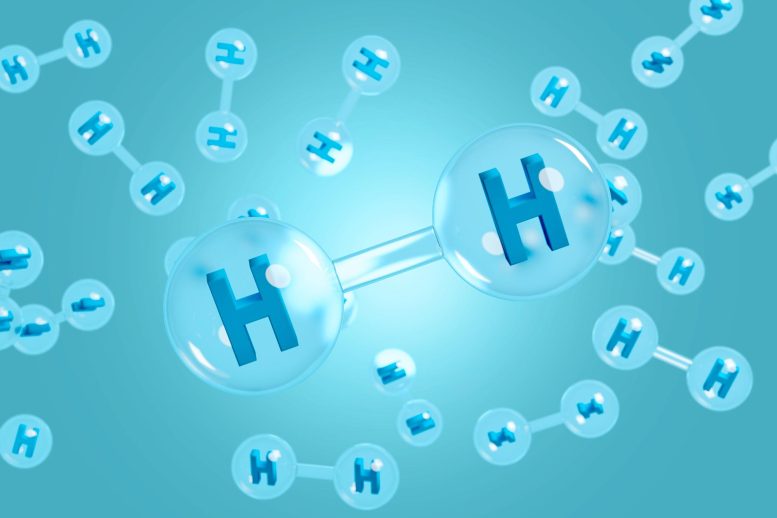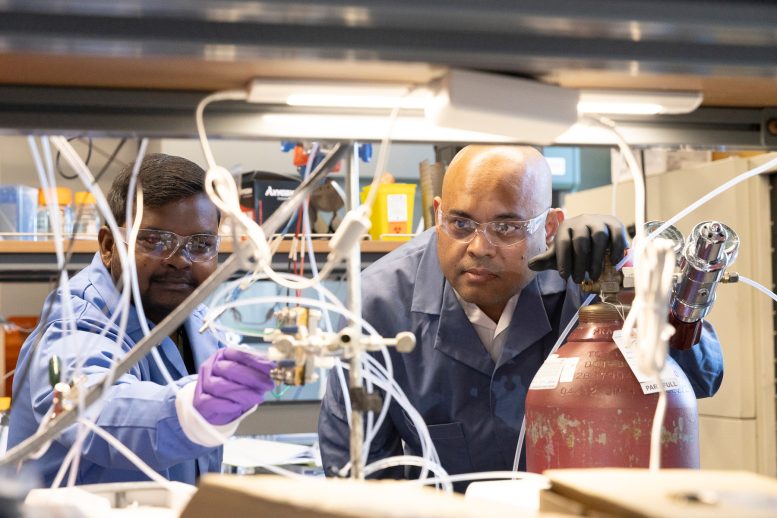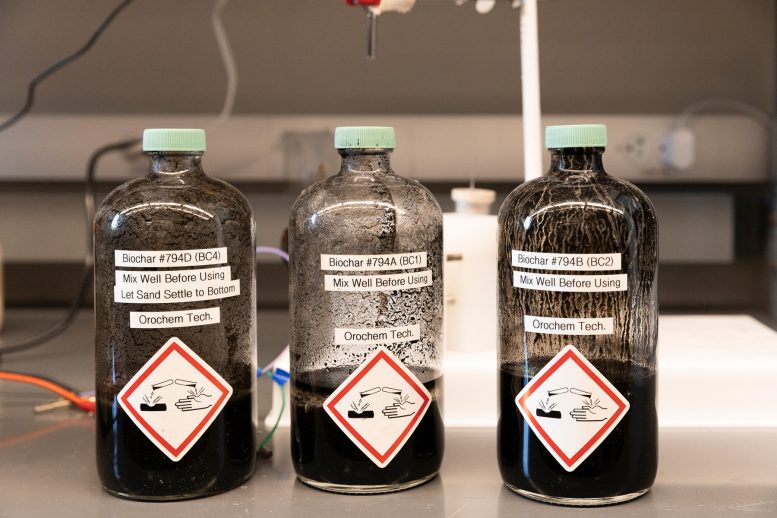
UIC engineers developed a method to produce hydrogen from water using solar power and agricultural waste, cutting energy needs by 600%. This process uses biochar to lower electricity requirements, achieving high efficiency and offering potential net-zero emissions.
UIC engineers have introduced a groundbreaking method for producing hydrogen gas using solar power and agricultural waste, drastically reducing energy consumption and enabling net-zero greenhouse emissions.
Engineers from the University of Illinois Chicago have developed a novel method to produce hydrogen gas from water using solely solar power and agricultural byproducts like manure and husks. This technique slashes the energy required to extract hydrogen from water by 600%, paving the way for more sustainable and environmentally friendly chemical manufacturing.
Hydrogen-based fuels are one of the most promising sources of clean energy. But producing pure hydrogen gas is an energy-intensive process that often requires coal or natural gas and large amounts of electricity.
Innovative Approach by UIC Engineers
In a paper for Cell Reports Physical Science, a multi-institutional team led by UIC engineer Meenesh Singh unveils the new process for green hydrogen production.
The method uses a carbon-rich substance called biochar to decrease the amount of electricity needed to convert water to hydrogen. By using renewable energy sources such as solar power or wind and capturing byproducts for other uses, the process can reduce greenhouse gas emissions to net zero.
“We are the first group to show that you can produce hydrogen utilizing biomass at a fraction of a volt,” said Singh, associate professor in the Department of Chemical Engineering. “This is a transformative technology.”
Redefining Electrolysis with Biochar
Electrolysis, the process of splitting water into hydrogen and oxygen, requires an electric current. At an industrial scale, fossil fuels are typically required to generate this electricity.
Recently, scientists have decreased the voltage required for water splitting by introducing a carbon source to the reaction. But this process also uses coal or expensive chemicals and releases carbon dioxide as a byproduct.
Singh and colleagues modified this process to instead use biomass from common waste products. By mixing sulfuric acid with agricultural waste, animal waste or sewage, they create a slurry-like substance called biochar, which is rich in carbon.
The team experimented with different kinds of biochar made from sugarcane husks, hemp waste, paper waste, and cow manure. When added to the electrolysis chamber, all five biochar varieties reduced the power needed to convert water to hydrogen. The best performer, cow dung, decreased the electrical requirement sixfold to roughly a fifth of a volt.

Associate Professor Meenesh Singh, right, and postdoctoral researcher Rohit Chauhan work in Singh’s laboratory at the University of Illinois Chicago. Credit: Jenny Fontaine/ UIC
Achievements and Future Plans
The energy requirements were low enough that the researchers could power the reaction with one standard silicon solar cell generating roughly 15 milliamps of current at 0.5 volts. That’s less than the amount of power produced by an AA battery.
“It’s very efficient, with almost 35% conversion of the biochar and solar energy into hydrogen,” said Rohit Chauhan, a co-author and postdoctoral scholar in Singh’s lab. “These are world record numbers; it’s the highest anyone has demonstrated.”
To make the process net-zero, it must capture the carbon dioxide generated by the reaction. But Singh said this too could have environmental and economic benefits, such as producing pure carbon dioxide to carbonate beverages or converting it into ethylene and other chemicals used in plastic manufacturing.
“It not only diversifies the utilization of biowaste but enables the clean production of different chemicals beyond hydrogen,” said UIC graduate Nishithan Kani, co-lead author on the paper. “This cheap way of making hydrogen could allow farmers to become self-sustainable for their energy needs or create new streams of revenue.”
Reference: “Sub-volt conversion of activated biochar and water for H2 production near equilibrium via biochar-assisted water electrolysis” by Nishithan C. Kani, Rohit Chauhan, Samuel A. Olusegun, Ishwar Sharan, Anag Katiyar, David W. House, Sang-Won Lee, Alena Jairamsingh, Rajan R. Bhawnani, Dongjin Choi, Adam C. Nielander, Thomas F. Jaramillo, Hae-Seok Lee, Anil Oroskar, Vimal C. Srivastava, Shishir Sinha, Joseph A. Gauthier and Meenesh R. Singh, 30 May 2024, Cell Reports Physical Science.
DOI: 10.1016/j.xcrp.2024.102013
Orochem Technologies Inc., which sponsored the research, has filed for patents on their processes for producing biochar and hydrogen, and the UIC team plans to test the methods on a large scale.
In addition to Singh, Kani, and Chauhan, the paper was co-authored by UIC graduate student Rajan Bhawnani. Other co-authors come from Stanford University, Texas Tech University, Indian Institute of Technology Roorkee, Korea University, and Orochem Technologies Inc.









Definately promising research, but one way or another youneed an awful lot of infrastructure to utilize this method. Producing and storing hydrogen requires high pressure pumps, specialized piping and storage materials. So do we transport manure, which is utilized at the farm level as fertilizer, to a central location or do we build out a distributed production system that is used to produce hydrogen that is used on site?
Both methods require large investments and produce the side effect of requiring additional man made fertilizers.
In Chicago; so why didn’t they use the sludge from Chicago’s sewage treatment plant? Sulfuric Acid isn’t exactly an eco friendly waste product. Somewhat strange that they added the free energy of sunlight into the overall efficiency equation, and for that matter the harvested waste products; why not just the electricity used? 35% of the dung was used? The other 65% was now contaminated with sulfuric acid and would need to dumped at a toxic waste site? Mixed with ground limestone to produce calcium chloride? 3% solution I’m guessing; same as if it were to be heated for the production of an alpha keto carboxylic acid? Might work as road salt, but the organic portion, would probably make that highly improbable. I don’t see it; it’s a university; where were the advisors?
from the name it seems something must *burned*, (*carbon*, eeeeewwwww!), to create ‘biochar’.
funny how the story has not one word regarding the unit cost in dollars, labor, energy, of producing and distrubuting ‘biochar’; nor any other number datum in re remotely useful to readers…